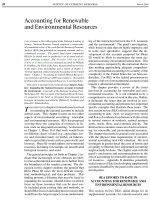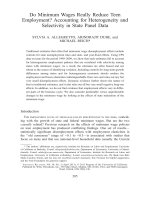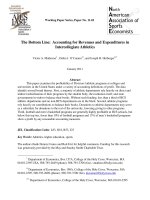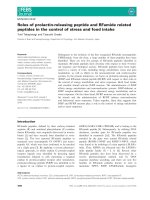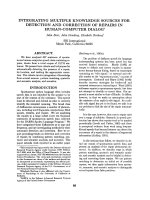7 ACCOUNTING FOR SALARY AND PAYROLL RELATED COMPENSATIONS IN ICPARTNERS VIETNAM CO , LTD
Bạn đang xem bản rút gọn của tài liệu. Xem và tải ngay bản đầy đủ của tài liệu tại đây (7.01 MB, 131 trang )
MINISTRY OF FINANCE
ACADEMY OF FINANCE
----------
NGUYEN THI DIEU LINH
CQ55/21.15
GRADUATION THESIS
TOPIC:
ACCOUNTING FOR SALARY AND PAYROLL RELATED
COMPENSATIONS IN IC&PARTNERS VIETNAM CO., LTD
Major
Code
Instructor
: Corporate Accounting
: 21
: MSc Nguyen Ba Linh
HA NOI – 2021
GRADUATION THESIS
DECLARATION
I hereby to declare that this thesis is my own work and effort and that has
not been submitted anywhere for any award. Where other sources of
information have been used, they have been acknowledged.
The data and results described in the thesis are derived from the actual
situation of the practice company.
Ha Noi,……April, 2021
Student
Nguyen Thi Dieu Linh
Nguyen Thi Dieu Linh
1
CQ55/21.15
GRADUATION THESIS
ACKNOWLEDGEMENT
During the time studying at Academy of Finance, I received the support
from my family, my friends and the enthusiastic guidance of the teacher in
the school, especially the teachers in the Accounting Department who
impart the value knowledge of accounting to me as well as create
opportunities for me to have fact-finding about the IC&PARTNERS
VIETNAM Co., Ltd. Thanks to enthusiastic teaching and help, I have
overcome difficulties in life, study and in the process of completing my
final thesis.
First of all, I would like to express my endless thanks and gratefulness to
my supervisor Msc Nguyen Ba Linh. His kindly support and continuous
advices went through the process of completion of my thesis. His
encouragement and comments had significantly enriched and improved my
work. Without his motivation and instructions, the thesis would have been
impossible to be done effectively.
Next, I would like to thanks to Board of Directors of IC&PARTNERS
VIETNAM Co., Ltd, especially the sisters in accounting department who
spend their value time to help me collect relate data of my thesis.
Nguyen Thi Dieu Linh
2
CQ55/21.15
GRADUATION THESIS
TABLE CONTENTS
DECLARATION................................................................................................i
ACKNOWLEDGEMENT................................................................................ii
TABLE CONTENTS.......................................................................................iii
LIST OF DIAGRAMS.....................................................................................vi
LIST OF TABLES............................................................................................vi
LIST OF PICTURES.......................................................................................vi
LIST OF ABBREVIATIONS...........................................................................vi
INTRODUCTION.............................................................................................1
CHAPTER 1: GENERAL THEORY OF ACCOUNTING FOR SALARY
AND PAYROLL RELATED COMPENSATIONS IN ENTERPRISES...........4
1.1.
OVERVIEW OF ACCOUNTING FOR SALARY AND PAYROLL
RELATED COMPENSATIONS...................................................................4
1.1.1.
Definition of salary and payroll related compensations..............4
1.1.2.
The function of salary and the task of accounting for salary......8
1.1.3.
Changes in salary and social insurance regimes........................11
1.2.
THE BASIC CONTENT OF ACCOUNTING FOR SALARY AND
PAYROLL RELATED COMPENSATIONS IN ENTERPRISES..............12
1.2.1.
The form of salary payment in enterprises................................12
1.2.2.
Salary fund in enterprises..........................................................16
1.2.3.
The form of payroll related compensations according..............18
1.2.4.
General accouting for salary and payroll related compensations.....23
1.3.
ORGANISATION
SALARY
AND
OF
BOOKKEEPING
PAYROLL
RELATED
SYMSTEMS
FOR
COMPENSATIONS
ACCOUNTING..........................................................................................34
1.3.1.
Accounting books used in accounting for salary and payroll
related compensation...............................................................................35
Nguyen Thi Dieu Linh
3
CQ55/21.15
GRADUATION THESIS
1.3.2.
Accounting forms......................................................................38
1.3.3.
Presentation in financial statements..........................................38
1.4.
ACCOUNTING FOR SALARY AND PAYROLL RELATED
COMPENSATION IN THE APPLICATION ACCOUNTING..................41
CONCLUSION CHAPTER 1.........................................................................43
CHAPTER 2: ACCOUNTING FOR SALARY AND PAYROLL RELATED
COMPENSATION IN IC&PARTNERS VIETNAM CO., LTD.....................44
2.1.
Overview of the company................................................................44
2.1.1.
The foundatig and development of company............................44
2.1.2.
Characteristics of business operation of company...................46
2.1.3.
Characteristics of organizing management mechanism............47
2.1.4.
Characteristics of organizing accounting system......................49
2.2.
Human resources in ICP..................................................................53
2.2.1.
Characteristics of labor in ICP..................................................53
2.2.2.
Classification of labor in the company......................................54
2.2.3.
Labor management in ICP.........................................................55
2.3.
PRACTICAL SITUATION OF ACCOUNTING FOR SALARY
AND PAYROLL RELATED COMPENSATIONS IN IC&PARTNERS
VIETNAM CO., LTD..................................................................................59
2.3.1.
Classification of salary in ICP...................................................59
2.3.2.
The form of salary payment and salary calculation in ICP.......61
2.3.3.
Documents/ Vouchers used in accounting for salary and payroll
related compensation...............................................................................61
2.3.4.
Accounts used in accounting for salary and payroll related......75
2.3.5.
Insurance and personal income tax for foreigners....................78
2.3.6.
Accounting forms and books in company.................................81
Nguyen Thi Dieu Linh
4
CQ55/21.15
GRADUATION THESIS
2.4.
EVALUATION OF ACCOUTING FOR SALARY AND PAYROLL
RELATED COMPENSATIONS IN IC&PARTNERS VIETNAM CO., LTD
94
2.4.1.
Strength.....................................................................................94
2.4.2.
Weakness...................................................................................98
CONCLUSION CHAPTER 2.......................................................................101
CHAPTER 3: SOME SUGGESTIONS FOR IMPROVEMENT OF
ACCOUNTING
FOR
SALARY
AND
PAYROLL
RELATED
COMPENSATIONS IN IC&PARTNERS VIETNAM CO., LTD................102
3.1.
Some require the completion of solutions to improve the salary
accounting system.....................................................................................102
3.1.1.
Some ways to implement solutions to improve salary accounting
system .................................................................................................104
3.1.2.
Some conditions for implementing the solution to improve the
salary accounting system.......................................................................119
CONCLUSION CHAPTER 3.......................................................................120
CONCLUSION.............................................................................................121
LIST OF REFERENCES..............................................................................122
Nguyen Thi Dieu Linh
5
CQ55/21.15
GRADUATION THESIS
LIST OF DIAGRAMS
LIST OF TABLES
LIST OF PICTURES
LIST OF ABBREVIATIONS
No.
1
2
3
Abbreviations
Acc
BOD
Cr
Description
Account
Board of director
Credit
4
Dr
Debit
5
ICP
IC&PARTNERS Vietnam Co., Ltd
6
PIT
Personal Income Tax
7
8
VAT
VND
Value Added Tax
Vietnam Dong
Nguyen Thi Dieu Linh
6
CQ55/21.15
GRADUATION THESIS
INTRODUCTION
1. Rational of the study
The economy of our country is now a market economy, salaries are one of
the issues that are most concerned by the State and Society. Because only a
small change in the salary policy of the State entails changing the daily life
of millions of workers and the business results of all businesses.
For employees, salaries are a basic and important income: to feed
themselves and their families. For businesses, salaries are a part of the cost
of production, but the goal of businesses is to reduce the cost of lowering
the cost of products but cannot reduce the salary of workers.
So that the organization of labor management and salary payment properly
and reasonably will promote the spirit, sense of responsibility and the
attachment of employees to enterprises, this will be a premise for business
to reduce the cost of lowering product costs, contributing to increase profits
for businesses and create sustainable development for businesses.
Therefore, the accounting of salary and payroll related compensation in
enterprises is a very important stage. Based on the use of reasoning and
based on the actual situation at the unit, with the enthusiastic guidance of
MSc Nguyen Ba Linh and the staff in the company, I would like to study
the topic "Accounting salary and payroll related compensation at
IC&PARTNERS Vietnam Company Limited.”
2. The aims of the study
- System and clarification of basic theoretical issues on research topics.
- Researching and describing the situation of accounting of salary and
payroll related compensation at the company.
- Analyzing, evaluating and proposing a number of comments to improve
Nguyen Thi Dieu Linh
1
CQ55/21.15
GRADUATION THESIS
the accounting of salary and payroll related compensation at the
company.
3. Research methods
Methods: Accounting is economic science, with the object of research is
accounting of salary and payroll related compensation. Therefore, the
method of research is based on dialectical materialism and historical
materialism.
Specific research methods: To research and present research results, I
apply a combination of methods of theoretical research, field surveys,
interviews,
accounting
consultations,
and
statistics,
analysis,
comparison ... to collect and process documents.
Collect documents:
Conducting research on accounting of salary and payroll related
compensation through reference to syllabuses, books, circulars, decrees
... Observing and studying accounting documents and financial
statements in the Company in 2020 and information on the mass media.
Conduct interviews, get direct opinions of accountants and other
employees at the company ... and ask the instructor's opinions.
Summary of processing of collected documents is a justification for
research results: using descriptive statistical methods, qualitative
analysis and comparison between the situation and the theoretical basis
for deduction, induction and presentation of results.
4. The subject and scope of the study
- Research subjects: research on the theory and situation of accounting of
Nguyen Thi Dieu Linh
2
CQ55/21.15
GRADUATION THESIS
salary and payroll related compensation at the company (how to
calculate salary, how to transfer documents, payment methods and
salaries, etc.)
- Research scope:
About content: Focusing on studying the status of salary and payroll
related compensation at the company on the perspective of financial
accounting.
About space: Studying the status of accounting of salary and payroll
related compensation of the company.
About time: Researching the theoretical issues and surveying the
actual documents at the company in 2020
5. Structure of the thesis
Graduation thesis consists of 3 chapters:
Chapter 1:
Chapter 2:
General theory on salary and payroll related compensation.
Accounting for salary and payroll related compensation in
Chapter 3:
IC&PARTNERS Vietnam Company Limited.
Some suggestions for improvement of accounting for salary
and payroll related compensation in IC&PARTNERS
Vietnam Company Limited.
However, due to my first time exposing to the actual work as well as the
limited time and knowledge, my thesis can not avoid some mistakes in the
content and layout. I expect to receive the teacher’s reviews to make my
thesis perfect.
Nguyen Thi Dieu Linh
3
CQ55/21.15
GRADUATION THESIS
CHAPTER 1: GENERAL THEORY OF ACCOUNTING FOR SALARY
AND PAYROLL RELATED COMPENSATIONS IN ENTERPRISES
1.1. OVERVIEW OF ACCOUNTING FOR SALARY AND PAYROLL
RELATED COMPENSATIONS
1.1.1. Definition of salary and payroll related compensations
Definition of salary
-
According to Marxism's theory: Wage is a living expression of money
of labor value.
-
In the view of modern economists: Salaries are prices of labor,
determined by the supply and demand relationship in the labor market.
-
In Vietnam during the period of central planning, salaries are
understood as a part of the national income used to offset the inevitable
labor costs allocated by the State to public employees in the form of
currency, in accordance with labor distribution rules. Currently,
according to Article 55 - Vietnam Labor Code, the salary of employees
is agreed by both parties in the labor contract and paid according to
labor productivity, quality and work efficiency.
Salary is a part of social products expressed in money paid to employees
based on the quantity and quality of labor. It is a practical problem for
employees. Salaries are properly regulated, is a strong stimulus factor for
production, it stimulates workers to make efforts in production and work,
improving skills and technology to improve labor productivity.
Employees after using labor to create products are paid a certain amount of
salary. In terms of phenomena, we see that labor power is exchanged for
Nguyen Thi Dieu Linh
4
CQ55/21.15
GRADUATION THESIS
salary. So maybe the labor power is considered as a commodity, a special
commodity. And salaries are the prices of those special goods, labor goods.
Because labor power goods need to be exchanged on the labor market on
the basis of agreement between buyers and sellers, under the impact of the
rule of value, the law of supply and demand.
Therefore, the price of labor will vary according to the price of the
constituent elements as well as the labor supply and demand relationship.
Thus, when the wage is considered as the value of labor, this price will be
formed on the basis of the agreement between the employee and the
employer. The price of labor or salary can increase or decrease depending
on the supply and demand of labor power goods. Thus, the price of salary
often fluctuates but it must revolve around the value of labor power supply
as well as other normal goods, it requires objectively its correct and full
value calculation. On the other hand, how wage rates fluctuate must also
ensure a minimum living standard for workers to survive and continue to
work.
Definition of payroll related compensations
Payroll related compensactions include: Social insurance, Health insurance,
Labor union, Unemployment insurance
Social insurance
-
Social insurance is one of the important contents of social policies that
the state guarantees before the law for people in general and workers
in particular. Social insurance (social insurance) is a material
guarantee for workers, through social insurance to stabilize the lives
of workers and their families. On the basis of the contribution of
Nguyen Thi Dieu Linh
5
CQ55/21.15
GRADUATION THESIS
employees, employers and the protection of the state of social
insurance only perform functions to ensure that when workers and
their families are at risk such as illness, old age, maternity, labor
accident, unemployment, death.
-
So, the social insurance fund is a fund used to subsidize workers who
contribute to the fund in cases where they are incapable of working, sick,
maternity, etc.
-
Under the current financial regime:
For Vietnamese employees, the social insurance fund is calculated by
deducting 25.5% of the total salary fund, of which 17.5% is deducted
from enterprise expenses and 8% is deducted from employees'
salaries;
For foreign workers, the social insurance fund is calculated by
deducting 3.5% of the total salary fund, of which all 3.5% is
deducted from the expenses of foreign businesses and workers do not
have to contribute.
Health insurance
-
Health insurance is the monthly amount of employees and employers
paying for health insurance agencies to be covered when there is a
need for medical examination and treatment. This fund is formed by
deducting 4.5% of the total wage level (of which 3% is included in
production and business costs, the remaining 1.5% is contributed by
laborers). This rate applies to both Vietnamese and foreign workers.
-
Health insurance is fully paid to a specialized health insurance agency
(in the form of purchasing health insurance) to serve the care and
health protection for workers such as medical examination, treatment
Nguyen Thi Dieu Linh
6
CQ55/21.15
GRADUATION THESIS
and treatment, sick, etc.
Unemployment insurance
Unemployment insurance is a policy of the Party and State issued to
improve the system of social security policies in our country. The goal of
the unemployment insurance policy is to compensate a part of the income
for workers who lose their jobs or terminate their labor and employment
contracts, and create conditions for them to find suitable and stable new
jobs in the shortest time. This fund is formed by deducting a rate of 2% of
the total wage level (of which 1% is included in production and business
costs, the remaining 1% is contributed by laborers). According to Clause 1,
Article 3 of the 2013 Employment Law, foreigners working in Vietnam are
not required to participate in unemployment insurance.
Labor union
-
Labor union is a sum of money to maintain the operation of unit trade
unions and superior trade unions. These organizations work to protect
the rights and improve the lives of workers. This fund is formed by
deducting 2% of the total salary payable to employees and is included
in the production and business costs of the unit. This fund is managed
by trade unions.
-
Summary, strengthen labor management, improve and perfect the
allocation and effective use of the workforce, improve and perfect
salary regime, the use of social insurance, health insurance, labor
insurance and unemployment insurance fund are considered an
effective means to stimulate workers to stick with production and
business activities, improve skills and improve labor productivity.
Nguyen Thi Dieu Linh
7
CQ55/21.15
GRADUATION THESIS
1.1.2. The function of salary and the task of accounting for salary
The function of salary
a. Characteristics and functions of salary
Salary is the input factor of the production and business process, is the
advance capital and this is an expense in product cost
Function of reproducing labor power:
In the process of labor, human labor is gradually worn down along with the
process of creating products. In order to maintain and improve human
ability to work, it is necessary to reproduce the labor force. Therefore,
salary is one of the material premises that are capable of re-creating labor
on the basis of compensating for wasted labor, compensating through
satisfying consumer demand of employees.
-
Function as management tools of enterprises
For managers, salary is one of the tools to manage businesses.
Through the payment of salaries to employees, employers can conduct
inspections, monitoring and supervision of employees working
according to their organizational plans, in order to ensure the salary to
be paid, it must bring about high results and efficiency.
-
For businesses, salary a reasonable and valid expense which is
included in the production and business costs and product costs,
accumulated to pay employees.
Labor stimulating function (economic leverage)
Nguyen Thi Dieu Linh
8
CQ55/21.15
GRADUATION THESIS
A reasonable salary will be the driving force to promote production to
increase labor productivity. When paid properly, employees will be
passionate, actively work, promote the spirit of creative work, they will
stick their responsibilities closely with the interests of the business.
b. The importance
Salary has a huge role, it satisfies the needs of workers. Because salary is
the main source of income for workers, workers are at the core of allowing
businesses to pay them with salary to ensure a minimum life for them. At
the same time, it is also the expense that businesses spend on workers
because they have made products for businesses.
If the enterprise pays salary to employees unreasonably or for the sake of
pure profits, regardless of the interests of the workers, it will make the
workers unable to guarantee labor days and discipline as well labor quality.
At that time, the business will not achieve the cost savings of labor and
profits needed for businesses to exist, now both sides are not profitable.
Therefore, the salary payment for workers must be calculated in a
reasonable way for both parties to benefit and stimulate the employees to
be self-aware and enthusiastic. In addition, one of the tasks that needs to
pay attention is to monitor the work of salary and payroll related
compensation, listen to timely detection of disagreements or conflicts.
Factors affecting salary
Group of factors belonging to work:
- Complexity of the job that require high levels of knowledge and skills to
be solved will require high pay. The complex jobs often involve
Nguyen Thi Dieu Linh
9
CQ55/21.15
GRADUATION THESIS
training and experience requirements and so will affect the salary.
Complexity reflects the degree of difficulty and requirements required
to do the job.
- Conditions for doing the job: The dangerous and difficult conditions will
enjoy a higher salary than normal conditions. The distinction is to
compensate for the waste of energy and morale for the employees as
well as motivate them to be sustainable with the job.
Group of factors belongs to the employee
- Level of work completion
The salary and wages of each person also depends on the level of
their work completion. Even though the qualifications are the same,
if the job completion level is different then the salary must be
different. It is also an inevitable reflection of fairness in wage
policies
- Loyalty:
The people who are loyal to the organization are committed with the
organization. Paying for loyalty encourages employees to be dedicated
to the development of the organization. Loyalty and seniority are
related and reflect different values.
The task of accounting for salary
The tasks of accounting for salary include the following basic tasks:
- Organize to record, reflect and synthesize data on the number of
employees,
time
of
labor
results,
salary
calculation
and
compensation of salaries and allocations labor costs are in
accordance with the subjects of employment.
Nguyen Thi Dieu Linh
10
CQ55/21.15
GRADUATION THESIS
- Instruct and check the accounting staff in the production and business
departments, the departments fully comply with the initial records labor,
salaries in accordance with the regime and the right method.
- Making reports on labor, salary and salary compensation periodically
analyzes labor situation, situation of management and spending of salary and
supply salary’s fund information to management in a timely manner.
- The cost of labor, salary and the salary compensation is not only a
matter of business attention because it is an expense of businesses but also the
workers. Especially, because this is the main is in their interest, workers use
salary to stabilize their lives goods, for their daily necessities.
1.1.3. Changes in salary and social insurance regimes
Pursuant to The Resolution No. 954/2020/UBTVQH14 about changing to
personal income tax exemptions and This Resolution come into force from
July 01, 2020 and is applied from the tax period of 2020.
“Article 1. Exemptions
The exemptions specified in Clause 1 Article 19 of the Law on Personal
Income Tax No. 04/2007/QH12, amended by Law No. 26/2012/QH13, are
changed as follows:
1. Personal exemption: 11 million VND/month (132 million VND/year);
2. Dependent exemption: 4,4 million VND/dependent/month.”
1.2. THE BASIC CONTENT OF ACCOUNTING FOR SALARY AND
PAYROLL RELATED COMPENSATIONS IN ENTERPRISES
1.2.1. The form of salary payment in enterprises
Nguyen Thi Dieu Linh
11
CQ55/21.15
GRADUATION THESIS
1.2.1.1. Salary payment by timework:
Definition:
Salaries are paid according to the actual working time (labor days)
and the wage scale of workers. This payment is determined based on
the working time and the technical level of the employee
Conditions apply:
This form is mainly applied to management workers (office staff, business
managers ..) or production workers, only applied in machinery parts is
mainly or jobs that cannot be properly and accurately rated or because of
the nature of the production that, if paid by product, it will not guarantee
the product quality and will not bring practical effect.
Factors:
To pay salary over time, people base on three factors:
-
Actual labor days of employees
-
Salary unit price calculated according to workdays
-
Salary coefficient (rank coefficient)
Methods:
Monthly salary
Salary
payable in
the month
=
Overtime pay
= Minimum salary x Salary coefficient
Number of actual
working daysXin the
month of the
employee
= Hourly salary x Hourly salary
coefficient x Overtime
hours
Salary payable in
=
the day
The hourly salary coefficient is determined as follows:
Nguyen Thi Dieu Linh
12
CQ55/21.15
GRADUATION THESIS
-
The 150% rate is applied to overtime working days.
-
The 200% rate is applied to overtime working on weekends and
holidays.
-
The 300% rate is applied to overtime working on holidays and daysoff paid according to regulations.
1.2.1.2. Salary payment by product:
Definition:
A form of payment according to the quantity and quality of products and
services they complete. The form of product payment is done in different
ways depending on the characteristics and production conditions of the
enterprise.
Conditions:
It is applied in conditions of labor norms on the basis of labor norms
assigned to individuals and calculate wage unit prices. This method
corresponds to the target of production and business plan selected as the
total of in-kind products (including converted products), normally applied
to enterprises producing and trading one or several types of products that
can be converted and tested in a specific way.
Methods:
Unit wage per product
-
Salary payment by products with reward: applied to workers directly
or indirectly with the aim of encouraging workers to increase labor
Nguyen Thi Dieu Linh
13
CQ55/21.15
GRADUATION THESIS
productivity, saving materials. Bonus to complete the plan and product
quality.
-
Salary payment by progressive products: is the salary paid by direct
product combined with the progressive bonus according to the level of
completion of norms for products calculated for each person or a
group of employees. In addition, salary is paid in the form of final
product contracts.
-
Contracted salary according to workload: applied to workloads or
jobs that need to be completed in a given time. When implementing
this method of salary calculation, attention should be paid to checking
the progress and quality of work when completing the pre-acceptance
test, especially for construction works, because the hidden work
sections upon acceptance of completed work volume will be difficult
to detect.
1.2.1.3. Contracting according to workload
Definition:
A form of payment when employees complete a workload according to the
assigned quality.
Conditions:
It is applied in conditions of no labor norms and no contract to employees.
This form is applied to pay a group of workers when they complete a
certain amount of work and apply for jobs that require a lot of participants
to do.
Methods:
Nguyen Thi Dieu Linh
14
CQ55/21.15
GRADUATION THESIS
Salary = Package wage x Percentage of job completion
1.2.1.4. Mixed payroll forms
This is a form of pay that incorporates smoothly between form of salary
payment by time and salary payment by product. Applying this form of
payment, the employee's salary is divided into two parts:
-
Minimum salary: relatively stable to ensure the minimum income for
workers to stabilize their lives and their families. This part of salary
will be prescribed according to the basic salary and working day of the
employee in each month.
This is a form of salary payment where the salaries and bonuses of
collectives and employees depend on the actual income achieved and
the unit price by income.
-
Fluctuation parts: depending on the productivity, quality and
efficiency of each individual employee and the business results of the
enterprise.
1.2.1.5. Other forms of remuneration other than salary
In addition to salaries, bonuses are also a very important tool to stimulate
workers. In fact, the bonus is an additional amount of money to better
understand the principle of labor distribution.
Through bonuses, employees are recognized in the business and society for
their accomplishments, and it encourages the whole enterprise to strive to
Nguyen Thi Dieu Linh
15
CQ55/21.15
GRADUATION THESIS
achieve many achievements in their work.
There are many different types of bonuses and bonuses all depending on
the nature of the work and the production and business efficiency of the
businesses. In order to promote the effect of bonuses, enterprises need to
implement the material liability regime for cases of failing to fulfill tasks
and causing losses to enterprises. In addition to the bonuses, subsidies and
other non-wage revenues also have a great effect in encouraging labor.
1.2.2. Salary fund in enterprises
The total amount of salary calculated according to the number of
employees of the enterprise managed and paid by the enterprise. The
composition of the salary fund of the enterprise includes the
principal items: Salaries paid to employees during the actual
working time (salary by time, by product); salary paid to employees
during time to stop work, vacation time, time for school; types of salary
in production; regular allowances (extra work allowance, vocational
training allowance, responsibility allowance, seniority allowances, etc.)
-
Main salary fund: calculated according to workload completed or actual
working time of employees at the enterprise such as time-based salary,
product salary, bonuses based on salary, allowances.
-
Main salary: is the salary paid to employees during the time when they
perform their main duties, including the salary according to the level and
the allowances such as the responsibility allowance, the area allowance. ,
seniority allowances, ect.
-
Extra-salary fund: pay for the time that the employee does not work at the
enterprise but is still entitled to salary according to the provisions of the
Nguyen Thi Dieu Linh
16
CQ55/21.15
GRADUATION THESIS
current Labor Law such as leave, holidays, and holidays during the
machine failure.
-
Extra salaries: are salaries paid to employees during the time when they
perform their tasks other than their main duties and the time when they
stop working according to the regime entitled to salary, such as leave,
stop production, go to school or a meeting.
Source for forming salary fund:
Salary fund according to assigned unit prices.
Reserve salary fund from the previous year (if any).
Salary fund from other production - business and service activities in
addition to the salary unit price.
Salary fund supplemented from the remaining salary of the year,
quarter, and previous month.
-
Distribution of salary fund:
To ensure that the salary fund does not exceed the entitled wage fund,
accumulate the salary fund in the last months of the year or to reserve
a large salary fund, the total monthly salary fund is divided as follows:
Salaries paid directly to employees according to product salaries,
workload salary and time salary is 76% of the total salary fund.
Salary bonus is 12% of total salary fund.
Provision for the next year must not exceed 12% of the total salary
fund. At the end of the current year (2019), the Company will
balance and distribute (original interest) the provision fund of the
previous year (2018) to employees (including employees terminating
labor contracts) by salary rank.
Nguyen Thi Dieu Linh
17
CQ55/21.15
GRADUATION THESIS
1.2.3. The form of payroll related compensations according
1.2.1.6. Salary fund
Salary fund is the entire amount payable to all types of laborers
managed and used by enterprises, both inside and outside the
enterprise. According to the proposal No. 235 / ĐBT of September
19, 1985 of the Council of Ministers (now the Government), salary
fund includes the following:
- Monthly, daily salary based on the salary scale coefficient of the
State.
- Salary paid by product
- Daily remuneration for off-pay workers
- Salary paid to employees when making defective products inside
rule.
- Salary paid to employees during the work stoppage due to
equipment the machine stopped working for objective reasons.
- Salary paid to employees during the time of work assignment or
doing the obligations of the State and society.
- Salary paid to employees taking periodical leave, vacation leave
regime of the State.
- Salary paid to people who go to school but still on the payroll.
- Types of regular bonuses
- Allowances according to the prescribed regime and other
allowances are recorded in salaries.
In terms of accounting, salaries for employees in the business
production industry is divided into two types: main salary and extra
salary. Salary is the salary paid to the employee in time employees
perform their main task, meaning time is wasted really labor
includes salary based on salaries and allowances attached
(responsibility allowance, area allowance, overtime pay ...). Extra
salary is the salary paid to employees during the time of performing
the duties cases other than their main tasks and the time employees
Nguyen Thi Dieu Linh
18
CQ55/21.15
